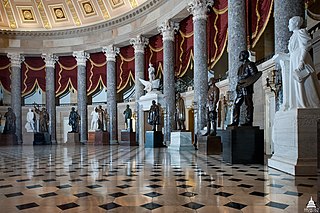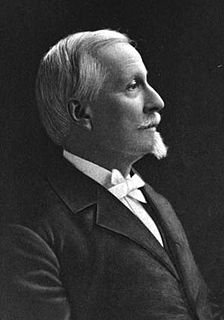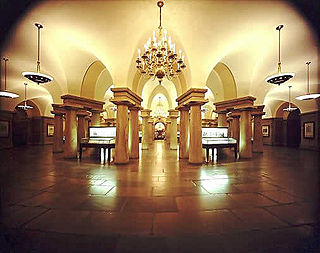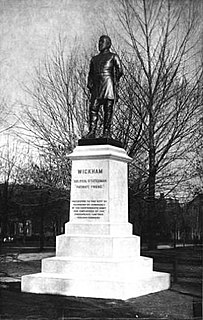
The National Statuary Hall is a chamber in the United States Capitol devoted to sculptures of prominent Americans. The hall, also known as the Old Hall of the House, is a large, two-story, semicircular room with a second story gallery along the curved perimeter. It is located immediately south of the Rotunda. The meeting place of the U.S. House of Representatives for nearly 50 years (1807–1857), after a few years of disuse in 1864 it was repurposed as a statuary hall; this is when the National Statuary Hall Collection was established. By 1933 the collection had outgrown this single room, and a number of statues are placed elsewhere within the Capitol.

The National Statuary Hall Collection in the United States Capitol is composed of statues donated by individual states to honor persons notable in their history. Limited to two statues per state, the collection was originally set up in the old Hall of the House of Representatives, which was then renamed National Statuary Hall. The expanding collection has since been spread throughout the Capitol and its Visitor's Center.

Monroe Park is a 7.5 acres (3.0 ha) landscaped park 1 mile (1.6 km) northwest of the Virginia State Capitol Building in Richmond, Virginia. It is named after James Monroe, the fifth President of the United States (1817–1825). The park unofficially demarcates the eastern point of the Fan District and is Richmond's oldest park.

University Chapel of Washington and Lee University is a National Historic Landmark in Lexington, Virginia. It was constructed during 1867–68 at the request of Robert E. Lee, who was president of the school, and after whom the university is, in part, named. The Victorian brick architectural design was probably the work of his son, George Washington Custis Lee, with details contributed by Col. Thomas Williamson, an architect and professor of engineering at the neighboring Virginia Military Institute. Upon completion and during Robert E. Lee's lifetime it was known as the College Chapel. Lee was buried beneath the chapel in 1870.

Edward Virginius Valentine was an American sculptor born in Richmond, Virginia. He studied in Europe—in Paris with Thomas Couture and François Jouffroy, in Italy under Bonanti, and with August Kiss in Berlin. He briefly headed the Valentine Richmond History Center, which was founded by his brother, Mann S. Valentine Jr. The Wickham-Valentine House, part of the Valentine Museum in Richmond is on the National Register of Historic Places and was named for him and his brother. He died on October 19, 1930, in Richmond, Virginia.

The United States Capitol crypt is the large circular room filled with forty neoclassical Doric columns directly beneath the United States Capitol rotunda. It was built originally to support the rotunda as well as offer an entrance to Washington's Tomb. It currently serves as a museum and a repository for thirteen statues of the National Statuary Hall Collection.

The Robert E. Lee Monument in Richmond, Virginia, was the first installation on Monument Avenue in 1890, and would ultimately be the last monument removed from the site. Before its removal on September 8, 2021, the monument honored Confederate Civil War General Robert E. Lee, depicted on a horse atop a large marble base that stood over 60 feet tall. Constructed in France and shipped to Virginia, it remained the largest installation on Monument Avenue for over a century; it was first listed on the National Register of Historic Places in 2007 and the Virginia Landmarks Register in 2006.
Since the 1960s, many municipalities in the United States have removed monuments and memorials on public property dedicated to the Confederate States of America, and some, such as Silent Sam in North Carolina, have been torn down by protestors. The momentum to remove Confederate memorials increased dramatically following high-profile incidents including the Charleston church shooting (2015), the Unite the Right rally (2017), and the murder of George Floyd (2020). The removals have been driven by historical analysis that the monuments express and re-enforce white supremacy; memorialize an unrecognized, treasonous government, the Confederacy, whose founding principle was the perpetuation and expansion of slavery; and that the presence of these Confederate memorials over a hundred years after the defeat of the Confederacy continues to disenfranchise and alienate African Americans.

Edmund Kirby Smith is a bronze sculpture commemorating the Confederate States of America Army officer of the same name by C. Adrian Pillars, installed in the United States Capitol Visitor Center as part of the National Statuary Hall Collection. The statue was gifted by the state of Florida in 1922.

Alexander H. Stephens is a marble sculpture commemorating the American politician of the same name by Gutzon Borglum, installed in the United States Capitol as part of the National Statuary Hall Collection. The statue was gifted by the state of Georgia in 1927.

Jefferson Davis, created by Henry Augustus Lukeman, is a bronze sculpture of Jefferson Davis – a U.S. Senator, U.S. Secretary of War, plantation owner and the only President of the Confederate States of America – commissioned by the U.S. State of Mississippi for inclusion in National Statuary Hall Collection at the United States Capitol's National Statuary Hall, in Washington, D.C. The statue was controversial at the time of its unveiling and there have been efforts to remove it from the Capitol from 2015 onward.

The National Statuary Hall Collection holds statues donated by each of the United States, portraying notable persons in the histories of the respective states. Displayed in the National Statuary Hall and other parts of the United States Capitol in Washington, D.C., the collection includes two statues from each state, except for Virginia which currently has one, making a total of 99.

Richmond, Virginia, experienced a series of protests in the wake of the murder of George Floyd. Richmond was the first city in the Southeastern United States to see rioting following Floyd's murder. Richmond, formerly the capital of the short-lived Confederate States of America, saw much arson and vandalism to monuments connected with that polity, particularly along Monument Avenue.

The Jefferson Davis Memorial was a memorial for Jefferson Davis (1808–1889), president of the Confederate States of America from 1861 to 1865, installed along Richmond, Virginia's Monument Avenue, in the United States. The monument was unveiled on June 3, 1907. The bronze representation of Jefferson Davis was toppled by protesters during the George Floyd protests in June 2020.

The statue of the Confederate States of America cavalry general Williams Carter Wickham by Edward Virginius Valentine was installed in Richmond, Virginia's Monroe Park in 1891, near Virginia Commonwealth University's main campus. It was toppled in June 2020 during the George Floyd protests.

There are several works of art in the United States Capitol honoring former leaders of the Confederate States of America and generals in the Confederate States Army, including eight statues in the National Statuary Hall Collection, busts and portraits.













